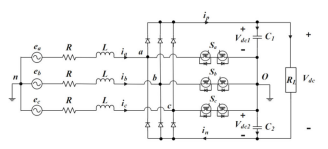An Improved Sliding Mode Direct Power Control Strategy Based on Reactive Power Compensation for Vienna Rectifier
Also Available Domains Power Quality
Objective
The main objective of this project is to compensate reactive power for Vienna rectifier by using an improved sliding mode DPC Controlling topology
Abstract
In this project, Vienna rectifiers are widely used in electric vehicle charging systems, wind power generation systems and other fields due to their excellent high-voltage resistance, small size and high efficiency. Aiming at the problems of the Vienna rectifier’s long response time, low anti-disturbance ability, and current zero crossing distortion, a new sliding mode direct power control strategy based on disturbance compensation is proposed. Firstly, a model considering the uncertainty is established, and the neural network is used to estimate and compensate the uncertain disturbance. Secondly, aiming at the slow approach speed and slow system convergence of traditional control methods, a new approaching law sliding mode direct power control strategy is designed. Aiming at the current zero-crossing distortion, the reason is analyzed and a compensation method is proposed. Finally, simulations and experiments show that the proposed method has no voltage overshoot and converges faster, effectively improving the problem of different phases of voltage and current. The rectifier operates at unit power, has better steady-state performance and stronger anti-load disturbance ability. The current total harmonic distortion is controlled below 2%, and the current quality is effectively improved. The simulation results can be evaluated by using Matlab/Simulink Software.
Keywords: — RBF neural network, sliding mode control, uncertain model, Vienna rectifier.
NOTE: Without the concern of our team, please don't submit to the college. This Abstract varies based on student requirements.
Block Diagram

Specifications
Software Configuration:
Operating System : Windows 7/8/10
Application Software : Matlab/Simulink
Hardware Configuration:
RAM : 8 GB
Processor : I3 / I5(Mostly prefer)
Learning Outcomes
- Introduction to Matlab/Simulink
- What is EISPACK & LINPACK
- How to start with MATLAB
- About Matlab language
- About tools & libraries
- Application of Matlab/Simulink
- About Matlab desktop
- Features of Matlab/Simulink
- Basics on Matlab/Simulink
- Introduction to controllers.
- Study of PWM techniques.
- Project Development Skills:
- Problem analyzing skills
- Problem solving skills
- Creativity and imaginary skills
- Programming skills
- Deployment
- Testing skills
- Debugging skills
- Project presentation skills
- Thesis writing skills


 Paper Publishing
Paper Publishing
